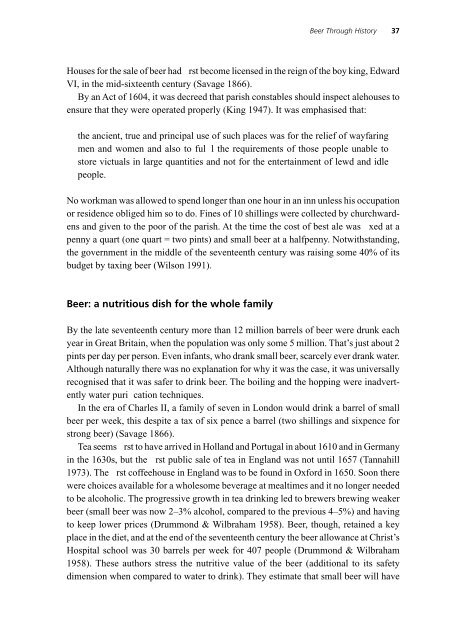Beer : Health and Nutrition
Beer : Health and Nutrition
Beer : Health and Nutrition
Create successful ePaper yourself
Turn your PDF publications into a flip-book with our unique Google optimized e-Paper software.
<strong>Beer</strong> Through History 37<br />
Houses for the sale of beer had rst become licensed in the reign of the boy king, Edward<br />
VI, in the mid-sixteenth century (Savage 1866).<br />
By an Act of 1604, it was decreed that parish constables should inspect alehouses to<br />
ensure that they were operated properly (King 1947). It was emphasised that:<br />
the ancient, true <strong>and</strong> principal use of such places was for the relief of wayfaring<br />
men <strong>and</strong> women <strong>and</strong> also to ful l the requirements of those people unable to<br />
store victuals in large quantities <strong>and</strong> not for the entertainment of lewd <strong>and</strong> idle<br />
people.<br />
No workman was allowed to spend longer than one hour in an inn unless his occupation<br />
or residence obliged him so to do. Fines of 10 shillings were collected by churchwardens<br />
<strong>and</strong> given to the poor of the parish. At the time the cost of best ale was xed at a<br />
penny a quart (one quart = two pints) <strong>and</strong> small beer at a halfpenny. Notwithst<strong>and</strong>ing,<br />
the government in the middle of the seventeenth century was raising some 40% of its<br />
budget by taxing beer (Wilson 1991).<br />
<strong>Beer</strong>: a nutritious dish for the whole family<br />
By the late seventeenth century more than 12 million barrels of beer were drunk each<br />
year in Great Britain, when the population was only some 5 million. That’s just about 2<br />
pints per day per person. Even infants, who drank small beer, scarcely ever drank water.<br />
Although naturally there was no explanation for why it was the case, it was universally<br />
recognised that it was safer to drink beer. The boiling <strong>and</strong> the hopping were inadvertently<br />
water puri cation techniques.<br />
In the era of Charles II, a family of seven in London would drink a barrel of small<br />
beer per week, this despite a tax of six pence a barrel (two shillings <strong>and</strong> sixpence for<br />
strong beer) (Savage 1866).<br />
Tea seems rst to have arrived in Holl<strong>and</strong> <strong>and</strong> Portugal in about 1610 <strong>and</strong> in Germany<br />
in the 1630s, but the rst public sale of tea in Engl<strong>and</strong> was not until 1657 (Tannahill<br />
1973). The rst coffeehouse in Engl<strong>and</strong> was to be found in Oxford in 1650. Soon there<br />
were choices available for a wholesome beverage at mealtimes <strong>and</strong> it no longer needed<br />
to be alcoholic. The progressive growth in tea drinking led to brewers brewing weaker<br />
beer (small beer was now 2–3% alcohol, compared to the previous 4–5%) <strong>and</strong> having<br />
to keep lower prices (Drummond & Wilbraham 1958). <strong>Beer</strong>, though, retained a key<br />
place in the diet, <strong>and</strong> at the end of the seventeenth century the beer allowance at Christ’s<br />
Hospital school was 30 barrels per week for 407 people (Drummond & Wilbraham<br />
1958). These authors stress the nutritive value of the beer (additional to its safety<br />
dimension when compared to water to drink). They estimate that small beer will have

















